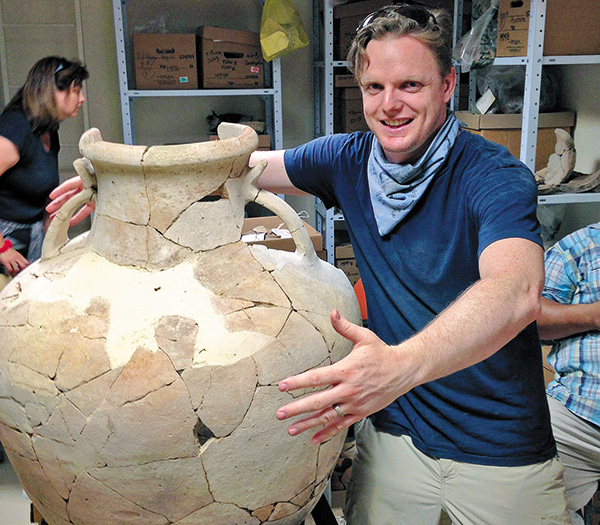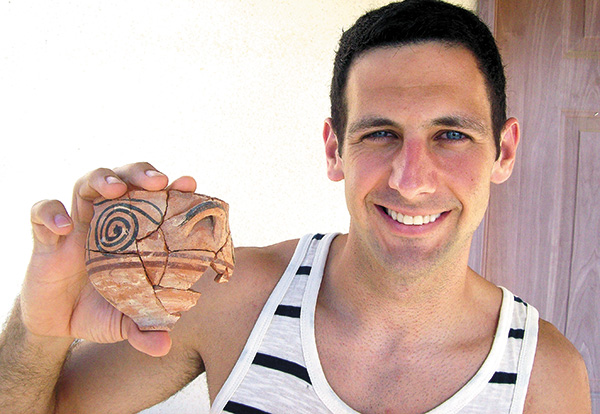Digs 2015
2014 Scholarship Recipients Go Digging
042
Straight from the field to you, hear from some of the individuals who were awarded BAR scholarships in 2014. They offer insight into what fieldwork at an archaeological excavation really looks like and whether the experience was worthwhile—all the while recognizing that their summer expeditions would not have been possible without the generous donations of the people who funded their scholarships.
Shaun Short

As this was my first trip to Israel, I was very excited to merely step foot in the country, breathe in the culture and—of course—get my hands dirty in that ancient soil. My entire trip was made all the more memorable by the excellent staff at Tel Burna. Dr. Itzhaq Shai and his team exude professionalism and scholarly passion, and their hospitality is unrivaled.
The first couple of days of excavation certainly took some getting used to, but once a rhythm was found, I can sincerely say that I doubt much will ever top the charm of my first dig experience. There truly is something magical about digging an ancient story out of the dirt and exhuming priceless artifacts that have been buried for more than 3,000 years.
One of the highlights of the dig season was the discovery of a tomb upon a section of rolling gradient to the north of the tel. I should actually say “rediscovery,” as this tomb was evidently looted by grave robbers some 40 years ago. We set about digging through some of the debris that the robbers left behind and through some loose soil at the tomb entrance, but aside from a 1970s cigarette lighter and an angry scorpion, we didn’t find anything too incredible. The prospect is truly exciting, however, and begs further investigation.
My second week on the site was the final week of the dig, so we set about cleaning everything up as best we could and washing loads of pottery. It was great to see it all come together. On our final day, I witnessed a fascinating technological achievement: A helicopter drone shot a series of aerial photos while doing a 360-degree circuit of the site—cool stuff! We also saw the prized collection of special finds from past seasons. I especially 043 fell in love with the enormous, imported jugs from Cyprus that date to the Late Bronze Age.
The crew at Tel Burna have some big plans for expansion next year, and I hope to join them in the mysteries awaiting discovery. My experience on the whole was just amazing, and there is so much more to tell that I cannot do justice to it in this brief description. I learned a great deal from merely being around the staff. I was very thankful for the lectures and some truly fascinating site tours and, of course, the gourmet food we were served at every meal. I am forever indebted to BAR for making the entire trip possible; without this generous scholarship, this would have amounted only to a pipe dream.
Zachary Margulies

Thanks to BAR’s support, I was able to return this summer to Tell es-Safi/Gath. Known primarily as part of the Philistine Pentapolis, Safi was also the site of a sprawling Canaanite city, a Judean town and a Crusader fortress. I worked in Area F, a stratigraphically challenging area near the summit of the tell, with sweeping views out to the Mediterranean (and a delightfully refreshing late morning breeze).
The process of discovery is one aspect of archaeology I love most: We continually recalibrate our conclusions based on the day’s new evidence. I was working down to a level that we expected to be Iron Age IIA, the time of the Arameans’ destruction of the city, but by midseason we readjusted it to the tenth century B.C.E., the time of David’s visit to Gath. By the end of the season, the pottery proved that we had actually reached the late Iron I (11th century B.C.E.), roughly contemporary with Samson or the Ark’s disastrous stay at Gath (1 Samuel 5). The clarity at the end of the season left me with the satisfaction of a successful summer.
Like those at many other digs in Israel, we could not ignore this summer’s political situation. Located within 25 miles of the Gaza Strip, Safi was well within range of the daily rocket fire. Prioritizing our safety, director Aren Maeir kept us off the tell until getting permission from the authorities to continue. For two days, we all chipped in to provide workshops on subjects as varied as pottery reading and yoga. Thankfully, we were back on the tell after two days and were able to finish the remaining weeks of a productive, successful and enjoyable season.
Straight from the field to you, hear from some of the individuals who were awarded BAR scholarships in 2014. They offer insight into what fieldwork at an archaeological excavation really looks like and whether the experience was worthwhile—all the while recognizing that their summer expeditions would not have been possible without the generous donations of the people who funded their scholarships.
You have already read your free article for this month. Please join the BAS Library or become an All Access member of BAS to gain full access to this article and so much more.
Already a library member? Log in here.
Institution user? Log in with your IP address or Username
